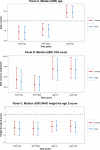Inequality in outcomes for adolescents living with perinatally acquired HIV in sub-Saharan Africa: a Collaborative Initiative for Paediatric HIV Education and Research (CIPHER) Cohort Collaboration analysis
- PMID: 29485724
- PMCID: PMC5978669
- DOI: 10.1002/jia2.25044
Inequality in outcomes for adolescents living with perinatally acquired HIV in sub-Saharan Africa: a Collaborative Initiative for Paediatric HIV Education and Research (CIPHER) Cohort Collaboration analysis
Abstract
Introduction: Eighty percent of adolescents living with perinatally and behaviourally acquired HIV live in sub-Saharan Africa (SSA), a continent with marked economic inequality. As part of our global project describing adolescents living with perinatally acquired HIV (APH), we aimed to assess whether inequality in outcomes exists by country income group (CIG) for APH within SSA.
Methods: Through the CIPHER cohort collaboration, individual retrospective data from 7 networks and 25 countries in SSA were included. APH were included if they entered care at age <10 years (as a proxy for perinatally acquired HIV) and had follow-up at age >10 years. World Bank CIG classification for median year of first visit was used. Cumulative incidence of mortality, transfer-out and loss-to-follow-up was calculated by competing risks analysis. Mortality was compared across CIG by Cox proportional hazards models.
Results: A total of 30,296 APH were included; 50.9% were female and 75.7% were resident in low-income countries (LIC). Median [interquartile range (IQR)] age at antiretroviral therapy (ART) start was 8.1 [6.3; 9.5], 7.8 [6.2; 9.3] and 7.3 [5.2; 8.9] years in LIC, lower-middle income countries (LMIC) and upper-middle income countries (UMIC) respectively. Median age at last follow-up was 12.1 [10.9; 13.8] years, with no difference between CIG. Cumulative incidence (95% CI) for mortality between age 10 and 15 years was lowest in UMIC (1.1% (0.8; 1.4)) compared to LIC (3.5% (3.1; 3.8)) and LMIC (3.9% (2.7; 5.4)). Loss-to-follow-up was highest in UMIC (14.0% (12.9; 15.3)) compared to LIC (13.1% (12.4; 13.8)) and LMIC (8.3% (6.3; 10.6)). Adjusted mortality hazard ratios (95% CI) for APH in LIC and LMIC in reference to UMIC were 2.50 (1.85; 3.37) and 2.96 (1.90; 4.61) respectively, with little difference when restricted only to APH who ever received ART. In adjusted analyses mortality was similar for male and female APH.
Conclusions: Results highlight probable inequality in mortality according to CIG in SSA even when ART was received. These findings highlight that without attention towards SDG 10 (to reduce inequality within and among countries), progress towards ensuring healthy lives and promoting wellbeing for all at all ages (SDG 3) will be hampered for APH in LIC and LMIC.
Keywords: HIV; Sustainable Development Goals; adolescent; perinatally acquired; sub-Saharan Africa.
© 2018 The Authors. Journal of the International AIDS Society published by John Wiley & sons Ltd on behalf of the International AIDS Society.
Figures


References
-
- UNICEF . State of the World's Children 2015: executive summary; 2015. [cited 2017 May 05]. Available from: https://www.unicef.org/publications/files/SOWC_2015_Summary_and_Tables.pdf.
-
- UNAIDS . UNAIDS 2016 estimates; 2016. [cited 2016 August 30]. Available from: http://aidsinfo.unaids.org/.
-
- Health for the world's adolescents: a second chance in the second decade Geneva, Switzerland: World Health Organization; 2014. [cited 2017 January 06]. Available from: http://apps.who.int/adolescent/second-decade/files/1612_MNCAH_HWA_Execut....
-
- Maskew M, Bor J, MacLeod W, Carmona S, Sherman G, Fox MP. The youth treatment bulge in South Africa: increasing numbers, inferior outcomes among adolescents on ART. International AIDS Conference; 19 July 2016; Durban, South Africa; 2016.
Publication types
MeSH terms
Substances
Grants and funding
LinkOut - more resources
Full Text Sources
Other Literature Sources
Medical
Research Materials

